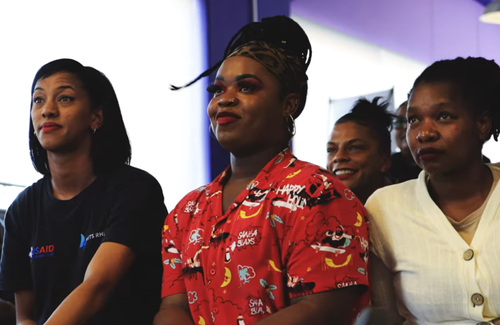
A South African study which included transgender women as core members of the research team found that the biggest gap in the HIV treatment cascade for trans women was the failure to suppress viral load among those receiving treatment.
The researchers focused on trans women living in three South African cities: Johannesburg, Cape Town, and Buffalo City. Johannesburg had the highest HIV prevalence rate of 63%, while Buffalo City and Cape Town had a rate of 46% each.
In Johannesburg, 54% of trans women with HIV knew their positive status, 82% of those aware were on ART and only 34% were virally suppressed. In Buffalo City, 24% were aware of their status, 78% were on treatment, and 41% were virally suppressed. In Cape Town, 40% were aware of their positive status, 65% of those aware were on ART, and 55% were virally suppressed.
"Johannesburg is doing better than Buffalo City and Cape Town for status awareness and ART coverage,” say the researchers. “The HIV care continuum outcomes for all three metropolitan municipalities are far below the UNAIDS 95-95-95 goals, showing poor rates of retention in treatment and viral suppression."
According to the researchers, innovative strategies are needed to diagnose and treat transgender women with HIV promptly to achieve viral load suppression.
Despite the high HIV prevalence in trans women in sub-Saharan Africa (a pooled prevalence of 25% across eight southern African countries, excluding South Africa), there are few studies with adequate sample sizes and measures designed explicitly for trans women to draw accurate conclusions and inform effective HIV strategies.
Trans women are often socially and economically excluded, rendering many invisible in research and programmes. This study aimed to estimate HIV prevalence and present data on the HIV care continuum indicators for trans women in three South African metropolitan municipalities.
The study
This study consisted of two phases: formative research (phase 1) from 2017 to 2018 and the main study (phase 2) from 2018 to 2019.
In phase 1, the researchers established a steering committee, comprising primarily trans women who were influencers and involved in trans-inclusive community organisations, who provided substantial input into the mixed methods study. To establish trust and cooperation with networks of trans women, the researchers participated in social events in the community, including attending trans-Diva beauty pageant competitions, participating in Pride events, and involving the trans community in selecting a name for the study.
The study had a team of trans women as core members. One of the study's co-investigators identifies as a trans woman, which helped establish ownership of the research and encouraged trans women to participate. The recruiters and interviewers also consisted of respected trans women who are considered veterans in the transgender movement. They used their connections to mobilise young trans women and new advocates to participate in the study.
The investigators also transferred research skills to trans women. This involved co-learning, providing researchers with an improved understanding and empowering trans women.
The objective of this phase was to assess the acceptability of recruiting trans women using respondent-driven sampling. This is a chain-referral methodology in which peers help recruit study participants, who then in turn help recruit other participants, and so on. This phase also helped identify the logistics needed to implement the HIV surveys successfully.
In phase two of the study, from July 2018 to March 2019, 887 eligible participants were enrolled: 305 in Buffalo City, 259 in Cape Town, and 323 in Johannesburg. The majority of participants in Johannesburg and Buffalo were between 18-24 years old and identified as Black African, while most participants from Cape Town were 25 years and above and identified as coloured. In all three cities, most participants were either students or unemployed and hence did not have any income.
Survey participants were eligible to participate in the study if they self-reported consensual sex with a man in the last six months before the survey; lived in one of the three cities; were assigned male sex at birth but identified current gender as female or trans, transgender, or transfemale, or identify as other rather than male or man.
After completing a questionnaire to assess HIV risk behaviours, survey participants who agreed to be tested provided blood specimens from a finger prick to test for HIV antibodies and determine the presence of ART in HIV-positive samples.
Results
The primary outcome measures were the 95-95-95 indicators defined as transgender women who tested positive and were aware of their HIV status; those who were aware and receiving treatment; and those who were aware, receiving treatment, and had a suppressed viral load of less than 1000 copies.
HIV prevalence was highest in Johannesburg, where 63% of tests were positive, followed by Buffalo City and Cape Town, where 46% were positive in both cities.
In Johannesburg, 54% (95% confidence interval 46–62%) of transgender women with HIV knew their positive status. In Buffalo City, this was 24% (15–36%), and in Cape Town 40% (27–53%). Among those who knew their status, 82% (73–89%) in Johannesburg, 78% (58–90%) in Buffalo City, and 65% (45–80%) in Cape Town were on ART. Of those on ART, 34% (27–42%) in Johannesburg, 41% (31–53%) in Buffalo City, and 55% (41–68%) in Cape Town were virally suppressed.
The largest gap in the treatment cascades of transgender women in the three cities was viral load suppression. However, as there are gaps at each stage of the care continuum, the cumulative result is that only 8% of all transgender women living with HIV in Buffalo City were virally suppressed. The figures for Cape Town and Johannesburg were only slightly better, at 14% and 15% respectively. This is of particular concern, given the high prevalence of HIV in this population.
The observed gaps along the HIV care cascade among transgender women in the selected areas were associated with racial groups other than Black South African, low educational attainment, not being exposed to outreach programmes, and non-adherence to treatment.
This study shows that none of the networks of transgender women in the sampled cities is close to achieving the UNAIDS 95-95-95 targets. To achieve UNAIDS' goals, there is an urgent need for trans-friendly services and strategies, including trans-led HIV initiatives to identify those who need HIV testing, link them to treatment and support them with staying in care, to ultimately achieve viral load suppression.
Cloete A et al. The HIV care continuum for transgender women in three Metropolitan Municipalities in South Africa: findings from the 2018–2019 bio-behavioral survey. Lancet HIV 10: e375-e384, June 2023.
https://doi.org/10.2139/ssrn.3962122.
van der Merwe LLA et al. Engaging transgender women in HIV research in South Africa. BMC Public Health 23: 990, 2023 (open access).

